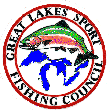|
 WILL REDUCE PCB LEVELS WILL REDUCE PCB LEVELS
November/96
New York Sea Grant recently conducted a study of contaminants in fish tissue and the uptake of PCBs in relation to stocking size. Sea Grant scientists have found that by changing certain fisheries management practices, PCBs can be reduced in fish tissue.
An obvious and radical departure from the feds new program to stock larger lake trout of 10-12 to the pound, these studies may have serious health and fiancial implications. US FWS, the Great Lakes Fishery Commission and a few other elitists have long promoted lake trout as the preferred dominant open water species of the Great Lakes.
These new studies may or at least should, make them a little more uncomfortable about their lake trout restoration project.
Stocking fish that are younger and smaller, so that contaminant uptake is lower during the first few years will reduce PCB levels.
In one study a 45% stocking size reduction of lake trout lead to an 18% reduction of PCB levels. Alewives, a more contaminated prey, are not as vulnerable to predation from small predatory fish.
Another suggested management practice change was to stock fish species with lower fat content. The drawbacks are that survival of small fish is lower than that of larger fish at stocking, and would increase lake trout hatchery and planting costs dramatically.
Other suggested changes in management practices included: stock predatory fish further offshore where contaminant loadings are less, and utilize management practices that promote increased predator growth rates (increased growth efficiency).
|

